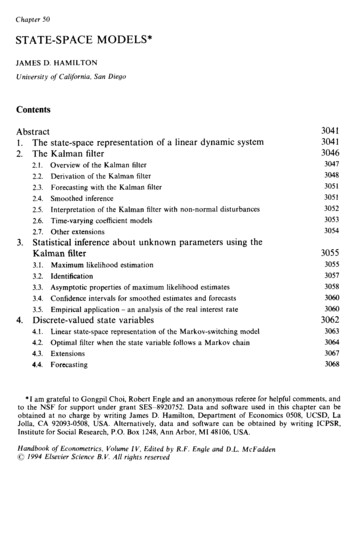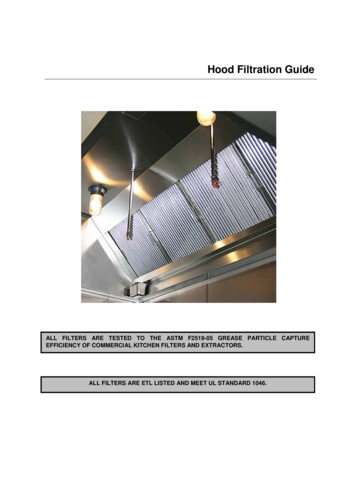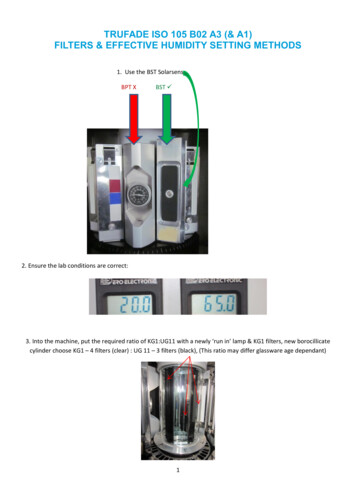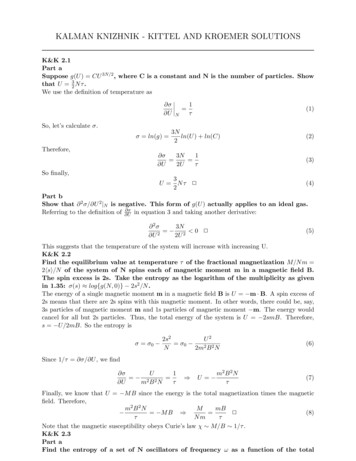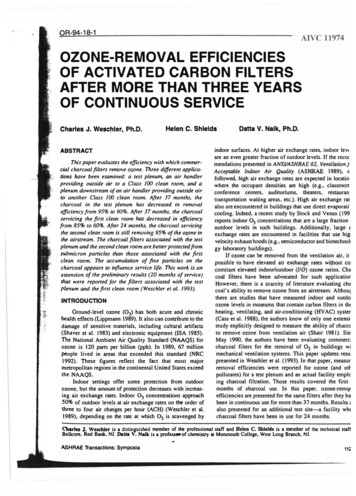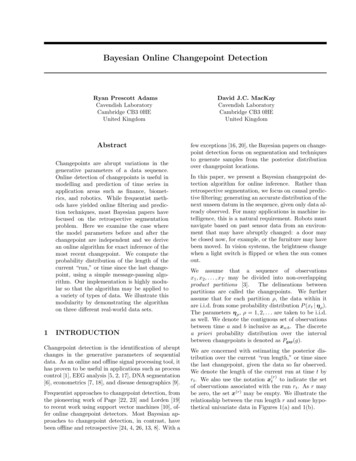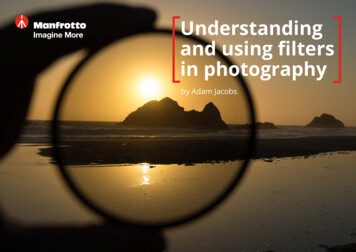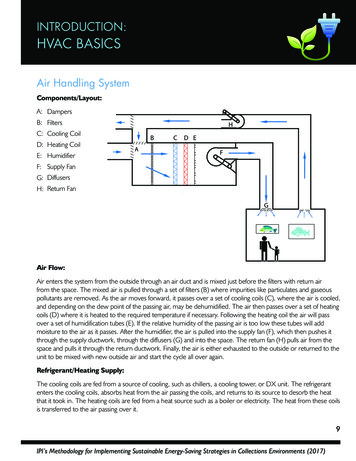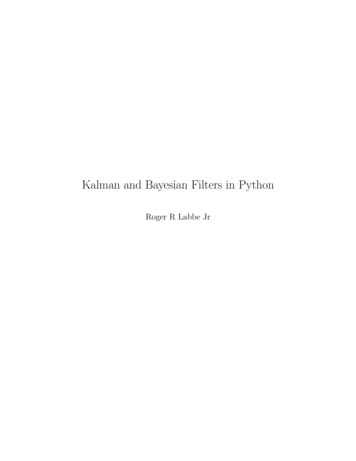
Transcription
Kalman and Bayesian Filters in PythonRoger R Labbe Jr
Contents1 Preface1.1 Motivation . . . . . . . . . . . . . . . .1.2 Reading the book on NBViewer . . . .1.3 Installation and Software Requirements1.4 Provided Libraries . . . . . . . . . . .1.5 License . . . . . . . . . . . . . . . . . .1.6 Contact . . . . . . . . . . . . . . . . .1.7 Resources . . . . . . . . . . . . . . . .2 910101111g-h FilterBuilding Intuition via Thought ExperimentsThe g-h Filter . . . . . . . . . . . . . . . . .Exercise: Write Generic Algorithm . . . . .2.3.1 Solution and Discussion . . . . . . .Choice of g and h . . . . . . . . . . . . . . .Exercise: create measurement function . . .2.5.1 Solution . . . . . . . . . . . . . . . .Exercise: Bad Initial Conditions . . . . . . .2.6.1 Solution and Discussion . . . . . . .Exercise: Extreme Noise . . . . . . . . . . .2.7.1 Solution and Discussion . . . . . . .Exercise: The Effect of Acceleration . . . . .2.8.1 Solution and Discussion . . . . . . .Exercise: Varying g . . . . . . . . . . . . . .2.9.1 Solution and Discussion . . . . . . .Varying h . . . . . . . . . . . . . . . . . . .Final Thoughts . . . . . . . . . . . . . . . .Summary . . . . . . . . . . . . . . . . . . .References . . . . . . . . . . . . . . . . . . 483 Discrete Bayes Filter3.1 Tracking a Dog . . . . . . . . . . . .3.2 Extracting Information from Multiple3.3 Noisy Sensors . . . . . . . . . . . . .3.4 Incorporating Movement Data . . . .1. . . .Sensor. . . . . . . . . . . .Readings. . . . . . . . . . .
3.53.63.73.83.93.103.11Adding Noise to the Prediction . . . . .Integrating Measurements and MovementThe Effect of Bad Sensor Data . . . . . .Drawbacks and Limitations . . . . . . .Generalizing to Multiple Dimensions . .Summary . . . . . . . . . . . . . . . . .References . . . . . . . . . . . . . . . . . . . . .Updates. . . . . . . . . . . . . . . . . . . . .505458606262634 Least Squares Filters4.1 Introduction . . . . . . . . . . . . . . . . . . . . . . . . . . . . . . . . . . . .64645 Gaussian Probabilities5.1 Introduction . . . . . . . . . . . . . . . . .5.2 Nomenclature . . . . . . . . . . . . . . . .5.3 Gaussian Distributions . . . . . . . . . . .5.4 Interactive Gaussians . . . . . . . . . . . .5.5 Computational Properties of the Gaussian5.6 Computing Probabilities with scipy.stats .5.7 Summary and Key Points . . . . . . . . .5.8 References . . . . . . . . . . . . . . . . . 08109110113114116117.6 Kalman Filters6.1 One Dimensional Kalman Filters . . . . . . . . . . . .6.2 Tracking A Dog . . . . . . . . . . . . . . . . . . . . . .6.3 Math with Gaussians . . . . . . . . . . . . . . . . . . .6.4 Implementing the Update Step . . . . . . . . . . . . .6.5 Implementing Predictions . . . . . . . . . . . . . . . .6.5.1 Animating the Tracking . . . . . . . . . . . . .6.6 Implementation in a Class (Optional) . . . . . . . . . .6.7 Relationship to the g-h Filter . . . . . . . . . . . . . .6.8 Introduction to Designing a Filter . . . . . . . . . . . .6.8.1 Animation . . . . . . . . . . . . . . . . . . . . .6.9 Explaining the Results - Multi-Sensor Fusion . . . . . .6.10 More examples . . . . . . . . . . . . . . . . . . . . . .6.10.1 Example: Extreme Amounts of Noise . . . . . .6.10.2 Example: Bad Initial Estimate . . . . . . . . .6.10.3 Example: Large Noise and Bad Initial Estimate6.10.4 Exercise: Interactive Plots . . . . . . . . . . . .6.10.5 Exercise - Nonlinear Systems . . . . . . . . . .6.10.6 Exercise - Noisy Nonlinear Systems . . . . . . .6.11 Summary . . . . . . . . . . . . . . . . . . . . . . . . .2.
7 Multivariate Kalman Filters7.1 Introduction . . . . . . . . . . . . . . . . . . . . . . . . . . . .7.2 Multivariate Normal Distributions . . . . . . . . . . . . . . . .7.3 Unobserved Variables . . . . . . . . . . . . . . . . . . . . . . .7.4 Kalman Filter Algorithm . . . . . . . . . . . . . . . . . . . . .7.5 The Equations . . . . . . . . . . . . . . . . . . . . . . . . . . .7.5.1 Kalman Equations Expressed as an Algorithm . . . . .7.6 Implementation in Python . . . . . . . . . . . . . . . . . . . .7.7 Tracking a Dog . . . . . . . . . . . . . . . . . . . . . . . . . .7.8 Implementing the Kalman Filter . . . . . . . . . . . . . . . . .7.9 Compare to Univariate Kalman Filter . . . . . . . . . . . . . .7.10 Converting the Multivariate Equations to the Univariate Case7.11 Adjusting the Filter . . . . . . . . . . . . . . . . . . . . . . . .7.11.1 Designing Q . . . . . . . . . . . . . . . . . . . . . . . .7.11.2 Designing R . . . . . . . . . . . . . . . . . . . . . . . .7.12 A Detailed Examination of the Covariance Matrix . . . . . . .7.13 Question: Explain Ellipse Differences . . . . . . . . . . . . . .7.13.1 Solution . . . . . . . . . . . . . . . . . . . . . . . . . .7.14 Walking Through the KalmanFilter Code (Optional) . . . . .7.15 References . . . . . . . . . . . . . . . . . . . . . . . . . . . . 731741751798 Kalman Filter Math8.1 Modeling a Dynmaic System that Has Noise . . . . . . . .8.2 Modelling Dynamic Systems . . . . . . . . . . . . . . . . .8.2.1 Finding the Fundamental Matrix for Time Invariant8.3 Walking Through the Kalman Filter Equations . . . . . .8.4 Design of the Process Noise Matrix . . . . . . . . . . . . .8.5 References . . . . . . . . . . . . . . . . . . . . . . . . . . . . . . . . . . .Systems. . . . . . . . . . . . .1801801821831841891899 Designing Kalman Filters9.1 Introduction . . . . . . . . . .9.2 Tracking a Robot . . . . . . .9.3 Implement the Filter Code . .9.4 Tracking a Ball . . . . . . . .9.5 Tracking a Ball in Air . . . .9.5.1 Implementing Air Drag9.5.2 Tracking Noisy Data .10 The10.110.210.3.190190190196200209210219Extended Kalman FilterThe Problem with Nonlinearity . . . . . . . . . . . . . .The Effect of Nonlinear Transfer Functions on GaussiansThe Extended Kalman Filter . . . . . . . . . . . . . . . .10.3.1 Example: Tracking a Flying Airplane . . . . . . .10.3.2 Example: A falling Ball . . . . . . . . . . . . . .220220221226230235.3.
11 Unscented Kalman Filters11.1 Choosing Sigma Points . .11.2 The Unscented Transform11.3 Implementation . . . . . .11.4 Unscented Kalman Filter .12 Designing Nonlinear Kalman Filters12.1 Introduction . . . . . . . . . . . . . .12.1.1 Kalman Filter with Air Drag12.2 Realistic 2D Position Sensors . . . .12.3 Linearizing the Kalman Filter . . . .12.4 References . . . . . . . . . . . . . . .237239242243248.24924924925025825813 Appendix: Installation, Python, Numpy, and filterpy14 Appendix I : Symbology14.0.1 measurement . . . . . .14.0.2 control transition Matrix14.1 Nomenclature . . . . . . . . . .14.1.1 Equations . . . . . . . .4.259.260260260261261
Contents5
Chapter 1PrefaceIntroductory textbook for Kalman filters and Bayesian filters. All code is written in Python,and the book itself is written in Ipython Notebook so that you can run and modify the codein the book in place, seeing the results inside the book. What better way to learn?Reading OnlineYou may access this book via nbviewer at any time by using this address: Read Online NowThe quickest way to read the book is to read it online using the link above. Thebook is written as a collection of IPython Notebooks, an interactive, browser based system that allows you to combine text, Python, and math into your brower. The websitehttp://nbviewer.org provides an IPython Notebook server that renders notebooks stored atgithub (or elsewhere). The rendering is done in real time when you load the book. If youread my book today, and then I make a change tomorrow, when you go back tomorrow youwill see that change. Perhaps more importantly, the book uses animations to demonstratehow the algorithms perform over time. The PDF version of the book, discussed in the nextparagraph, cannot show the animations.If you click on the link above it will take you to a table of contents which links you tothis Preface as well as all of the chapters of the book. The top of each page also gives youlinks that show you where you are in the directory structure - clicking on the title of thebook will take you to the top directory, which contains a subdirectory for each chapter. Thatis not nearly as nice as using the table of contents, but it does allow you to see all of thesupporting material for the book as well.PDF VersionI periodically generate a PDF of the book from the Notebooks. I do not do this for everycheck in, so the PDF will usually lag the content in github and on nbviewer.org. However, Ido generate it whenever I make a substantial change.PDF Version of the book6
Downloading the bookHowever, this book is intended to be interactive and I recommend using it in that form.If you install IPython on your computer and then clone this book you will be able to runall of the code in the book yourself. You can perform experiments, see how filters react todifferent data, see how different filters react to the same data, and so on. I find this sort ofimmediate feedback both vital and invigorating. You do not have to wonder “what happensif”. Try it and see!The github pages for this project are at rs-in-Python You can clone it to your hard drive with the commandgit clone ers-in-Python.gitNavigate to the directory it was installed into, and run IPython notebook with thecommandipython notebookIf you need more instructions they are available in the static version of the book. Followthe link above, and read the installation appendix.Version 0.0Not ready for public consumption. In development.author’s note: The chapter on g-h filters is fairly complete as far as plannedcontent goes. The content for the discrete Bayesian chapter, chapter 2, is alsofairly complete. After that I have questions in my mind as to the best way topresent the statistics needed to understand the filters. I try to avoid the ‘dumpa sememster of math into 4 pages’ approash of most textbooks, but then againperhaps I put things off a bit too long. In any case, the subsequent chapters aredue a strong editting cycle where I decide how to best develop these concepts.Otherwise I am pretty happy with the content for the one dimensional and multidimensional Kalman filter chapters. I know the code works, I am using it inreal world projects at work, but there are areas where the content about thecovariance matrices is pretty bad. The implementation is fine, the description ispoor. Sorry. It will be corrected.Beyond that the chapters are much more in a state of flux. Reader beware. Mywriting methodology is to just vomit out whatever is in my head, just to getmaterial, and then go back and think through presentation, test code, refine, andso on. Whatever is checked in in these later chapters may be wrong and notready for your use.Finally, nothing has been spell checked or proof read yet. I with IPython Notebook had spell check, but it doesn’t seem to.7
1.1MotivationThis is a book for programmers that have a need or interest in Kalman filtering. The motivation for this book came out of my desire for a gentle introduction to Kalman filtering.I’m a software engineer that spent almost two decades in the avionics field, and so I havealways been ‘bumping elbows’ with the Kalman filter, but never implemented one myself.They always has a fearsome reputation for difficulty, and I did not have the requisite education. Everyone I met that did implement them had multiple graduate courses on the topicand extensive industrial experience with them. As I moved into solving tracking problemswith computer vision the need to implement them myself became urgent. There are classictextbooks in the field, such as Grewal and Andrew’s excellent Kalman Filtering. But sittingdown and trying to read many of these books is a dismal and trying experience if you do nothave the background. Typically the first few chapters fly through several years of undergraduate math, blithely referring you to textbooks on, for example, Itō calculus, and presentingan entire semester’s worth of statistics in a few brief paragraphs. These books are goodtextbooks for an upper undergraduate course, and an invaluable reference to researchersand professionals, but the going is truly difficult for the more casual reader. Symbology isintroduced without explanation, different texts use different words and variables names forthe same concept, and the books are almost devoid of examples or worked problems. I oftenfound myself able to parse the words and comprehend the mathematics of a definition, buthad no idea as to what real world phenomena these words and math were attempting todescribe. “But what does that mean? ” was my repeated thought.However, as I began to finally understand the Kalman filter I realized the underlyingconcepts are quite straightforward. A few simple probability rules, some intuition abouthow we integrate disparate knowledge to explain events in our everyday life and the coreconcepts of the Kalman filter are accessible. Kalman filters have a reputation for difficulty,but shorn of much of the formal terminology the beauty of the subject and of their mathbecame clear to me, and I fell in love with the topic.As I began to understand the math and theory more difficulties itself. A book or paper’sauthor makes some statement of fact and presents a graph as proof. Unfortunately, why thestatement is true is not clear to me, nor is the method by which you might make that plotobvious. Or maybe I wonder “is this true if R 0?” Or the author provides pseudocode - atsuch a high level that the implementation is not obvious. Some books offer Matlab code, butI do not have a license to that expensive package. Finally, many books end each chapter withmany useful exercises. Exercises which you need to understand if you want to implementKalman filters for yourself, but exercises with no answers. If you are using the book in aclassroom, perhaps this is okay, but it is terrible for the independent reader. I loathe thatan author withholds information from me, presumably to avoid ‘cheating’ by the student inthe classroom.None of this necessary, from my point of view. Certainly if you are designing a Kalmanfilter for a aircraft or missile you must thoroughly master of all of the mathematics andtopics in a typical Kalman filter textbook. I just want to track an image on a screen, orwrite some code for my Arduino project. I want to know how the plots in the book aremade, and chose different parameters than the author chose. I want to run simulations. Iwant to inject more noise in the signal and see how a filter performs. There are thousands of8
opportunities for using Kalman filters in everyday code, and yet this fairly straightforwardtopic is the provenance of rocket scientists and academics.I wrote this book to address all of those needs. This is not the book for you if youprogram avionics for Boeing or design radars for Ratheon. Go get a degree at Georgia Tech,UW, or the like, because you’ll need it. This book is for the hobbyist, the curious, and theworking engineer that needs to filter or smooth data.This book is interactive. While you can read it online as static content, I urge you touse it as intended. It is written using IPython Notebook, which allows me to combine text,python, and python output in one place. Every plot, every piece of data in this book isgenerated from Python that is available to you right inside the notebook. Want to doublethe value of a parameter? Click on the Python cell, change the parameter’s value, and click‘Run’. A new plot or printed output will appear in the book.This book has exercises, but it also has the answers. I trust you. If you just need ananswer, go ahead and read the answer. If you want to internalize this knowledge, try toimplement the exercise before you read the answer.This book has supporting libraries for computing statistics, plotting various things relatedto filters, and for the various filters that we cover. This does require a strong caveat; mostof the code is written for didactic purposes. It is rare that I chose the most efficient solution(which often obscures the intent of the code), and in the first parts of the book I didnot concern myself with numerical stability. This is important to understand - Kalmanfilters in aircraft are carefully designed and implemented to be numerically stable; the naiveimplementation is not stable in many cases. If you are serious about Kalman filters thisbook will not be the last book you need. My intention is to introduce you to the conceptsand mathematics, and to get you to the point where the textbooks are approachable.Finally, this book is free. The cost for the books required to learn Kalman filtering issomewhat prohibitive even for a Silicon Valley engineer like myself; I cannot believe the arewithin the reach of someone in a depressed economy, or a financially struggling student. Ihave gained so much from free software like Python, and free books like those from Allen B.Downey here [1]. It’s time to repay that. So, the book is free, it is hosted on free servers,and it uses only free and open software such as IPython and mathjax to create the book.1.2Reading the book on NBViewerIf you are reading this by using NBViewer, for the most part navigation should be clear.The link ”1.3Installation and Software RequirementsIf you want to run the notebook on your computer, which is what I recommend, then youwill have to have IPython installed. I do not cover how to do that in this book; requirementschange based on what other python installations you may have, whether you use a thirdparty package like Anaconda Python, what operating system you are using, and so on.To use all features you will have to have IPython 2.0 installed, which is released andstable as of April 2014. Most of the book does not require that, but I do make use of the9
interactive plotting widgets introduced in this release. A few cells will not run if you havean older version installed.You will need Python 2.7 or later installed. Almost all of my work is done in Python3.4, but I periodically test on 2.y. I do not promise any specific check in will work in 2.7,however. I do use Python’s “from future import . . . ” statement to help with compatibility.For example, all prints need to use parenthesis. If you try to add, say, “print 3.14” into thebook your script will fail; you must write “print (3.4)” as in Python 3.X.You will need a recent version of NumPy, SciPy, and Matplotlib installed. I don’t reallyknow what the minimal version requirement might be.I have numpy 1.71, SciPy 0.13.0, and Matplotlib 1.4.0 installed on my machines.Personally, I use the Anaconda Python distribution in all of my work, available here [3]. Iam not selecting them out of favoritism, I am merely documenting my environment. Shouldyou have trouble running any of the code, perhaps knowing this will help you.1.4Provided Librariesupdate: I have created the filterpy project, into which I am slowly moving a lotof this code. Some of the chapters use this project, some do not (yet). It is athttps://github.com/rlabbe/filterpy For the time being this book is it’s documentation; Icannot spend a lot of time working on the documentation for that library when I am writingthis book.I’ve not structured anything nicely yet. For now just look for any .py files in the basedirectory. As I pull everything together I will turn this into a python library, and probablycreate a separate git project just for the python code.There are python files with a name like xxx internal.py. I use these to store functionsthat are useful for the book, but not of general interest. Often the Python is the point andfocus of what I am talking about, but sometimes I just want to display a chart. IPythonNotebook does not allow you to collapse the python code, and so it sometimes gets in theway. Some IPython books just incorporate .png files for the image, but I want to ensurethat everything is open - if you want to look at the code you can.Some chapters introduce functions that are useful for the rest of the book. Those functionsare initially defined within the Notebook itself, but the code is also stored in a Python filethat is imported if needed in later chapters. I do document when I do this where the functionis first defined. But this is still a work in progress.1.5LicenseKalman Filters and Random Signals in Python by Roger Labbe is licensed under a CreativeCommons Attribution-NonCommercial-ShareAlike 4.0 International License.Based on a work at m-Signals-inPython.10
1.6Contactrlabbejr@gmail.com1.7Resources [1] http://www.greenteapress.com/ [2] ve/nbconvert.html [3] https://store.continuum.io/cshop/anaconda/11
Chapter 2The g-h Filter2.1Building Intuition via Thought ExperimentsImagine that we live in a world without scales - the devices you stand on to weigh yourself.One day at work a coworker comes running up to you and announces her invention of a ‘scale’to you. After she explains, you eagerly stand on it and announce the results: “172 lbs”. Youare ecstatic - for the first time in your life you know what you weigh. More importantly,dollar signs dance in your eyes as you imagine selling this device to weight loss clinics acrossthe world! This is fantastic!Another coworker hears the commotion and comes over to find out what has you soexcited. You explain the invention and once again step onto the scale, and proudly proclaimthe result: “161 lbs.” And then you hesitate, confused.“It read 172 lbs just a few seconds ago” you complain to your coworker.“I never said it was accurate,” she replies.Sensors are inaccurate. This is the motivation behind a huge body of work in filtering,and solving this problem is the topic of this book. I could just provide the solutions thathave been developed over the last half century, but these solutions developed by asking verybasic, fundamental questions into the nature of what we know and how we know it. Beforewe attempt the math, let’s follow that journey of discovery, and see if it does not inform ourintuition about filtering.Try Another Scale Is there any way we can improve upon this result? The obvious, firstthing to try is get a better sensor. Unfortunately, your co-worker informs you that she hasbuilt 10 scales, and they all operate with about the same accuracy. You have her bring outanother scale, and you weigh yourself on one, and then on the other. The first scale (A)reads “160 lbs”, and the second (B) reads “170 lbs”. What can we conclude about yourweight?Well, what are our choices? We could choose to only believe A, and assign 160lbs to our weight estimate.we could choose to only believe B, and assign 170lbs to our weight.We could choose a number less than either A or BWe could choose a number greater than either A or B12
We could choose a number between A and BThe first two choices are plausible, but we have no reason to favor one scale over theother. Why would we choose to believe A more than B? We have no reason for such a belief.The third and fourth choices are irrational. The scales are admittedly not very accurate,but there is no reason at all to choose a number outside of the range of what they measure.The final choice is the only reasonable one. If both scales are inaccurate, and as likely togive a result above my actual weight as below it, more often than not probably the answeris somewhere between A and B.In mathematics this concept is formalized as expected value, and we will cover it in depthlater. For now ask yourself what would be the ‘usual’ thing to happen if we made one millionseparate readings. Some of the times both scales will read too low, sometimes that will bothread too high, and the rest of the time they will straddle the actual weight. If they straddlethe actual weight then certainly we should choose a number between A and B. If they don’tstraddle then we don’t know if they are both too high or low, but by choosing a numberbetween A and B we at least mitigate the effect of the worst measurement. For example,suppose our actual weight is 180 lbs. 160 lbs is a big error. But if we choose a weight between160 lbs and 170 lbs our estimate will be better than 160 lbs. The same argument holds ifboth scales returned a value greater than the actual weight.We will deal with this more formally later, but for now I hope it is clear that our best 165.estimate is just the average of A and B. 160 1702Let’s play ‘what if’ some more. What if we are now told that A is three times moreaccurate than B? Consider the 5 options we listed above. It still makes no sense to choose anumber outside the range of A and B, so we will not consider those. It perhaps seems morecompelling to choose A as our estimate - after all, we know it is more accurate, why not justuse it instead of B? Can B possibly improve our knowledge over A alone?The answer, perhaps counter intuitively, is yes, it can. Consider this case. We know scaleA is accurate to 1 lb. In other words, if we weight 170 lbs, it could report 169, 170, or 171lbs. We know that scale B is accurate to 9 lbs. We do a reading, and A 160, and B 170.What should we estimate our weight to be?Well, if we say 160 lbs we would be wrong, because B can only be 9 pounds off, and 170lbs - 160 lbs is 10 lbs. 160 is not a possible measurement for B. In fact, the only numberthat satisfies all of the constraints is 161 lbs. That is 1 lb within the reading of A, and 9 lbswithin the reading of B.This is an important result. With two relatively inaccurate sensors we were able todeduce an extremely accurate result. Now sure, that was a specially constructed case, butit generalizes. What if A is accurate to 3 lbs, B is accurate to 11 lbs, and we get themeasurements of A 160 lbs and B 170 lbs? The result can only be from 159 lbs to 163 lbs,which is better than the range of 157 lbs to 163 lbs that is the range of values that A aloneallows.So two sensors, even if one is less accurate than the other, is better than one.However, we have strayed from our problem. No customer is going to want to buymultiple scales, and besides, we initially started with an assumption that all scales wereequally (in)accurate.13
So, what if I have one scale, but I weigh myself many times? We concluded that if wehad two scales of equal accuracy we should average the results of their measurements. Whatif I weigh myself 1,000,000 times with one scale? We have already stated that the scale isequally likely to return a number too large as it is to return one that is too small. I willnot prove it, but it can be proved that the average of a large number of weighings will beextremely close to my actual weight. Consider a simple case - the scale is accurate to within1 lb. If I weigh 170, it will return one of either 169, 170, or 171. The average of a bunch of170 is 170, so we can exclude those. What is left is measurements of 169 and 171. But weknow there will be as many 169s as there are 171s. The average of those will also be 170,and so the average of all must be 170, my true weight. It’s not that hard to extend this toany arbitrary accuracy.Okay, great, we have an answer! But it is not a very good answer. No one has thepatience to weigh themselves a million, or even a hundred times.So, let’s play ‘what if’ again. What if you measured your weight once a day, and got thereadings 170, 161, and then 169. Did you gain weight, lose weight, or is this all just noisymeasurements?We really can’t say. The first measurement was 170, and the last was 169, implyinga 1 lb loss. But if the scale is only accurate to 10 lbs, that is explainable by noise - badmeasurements. I could have actually gained weight; maybe my weight on day one was 165lbs, and on day three it was 172. It is possible to get those weight readings with that weightgain. My scale tells me I am losing weight, and I am actually gaining weight!Shall we give up? No, let’s play ‘what if’. Suppose I take
All code is written in Python, and the book itself is written in Ipython Notebook so that you can run and modify the code in the book in place, seeing the results inside the book. . check in, so the PDF will usually lag the content in github and on nbviewer.org. Howeve
